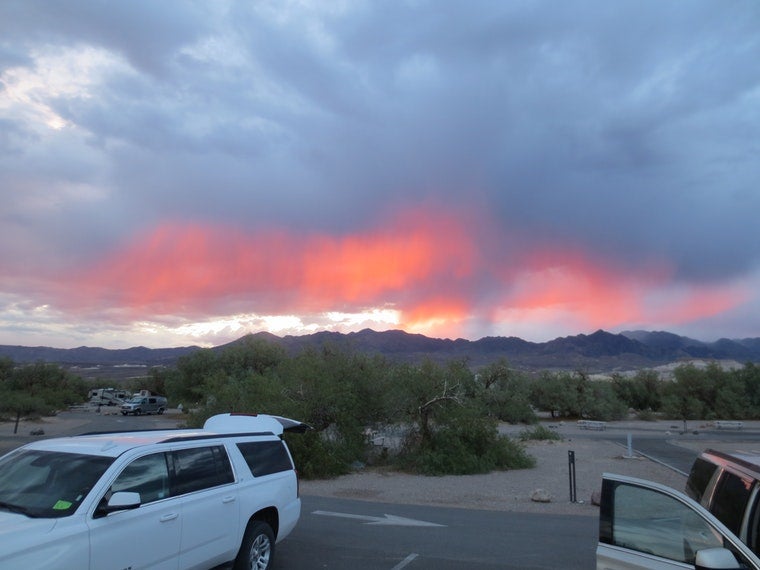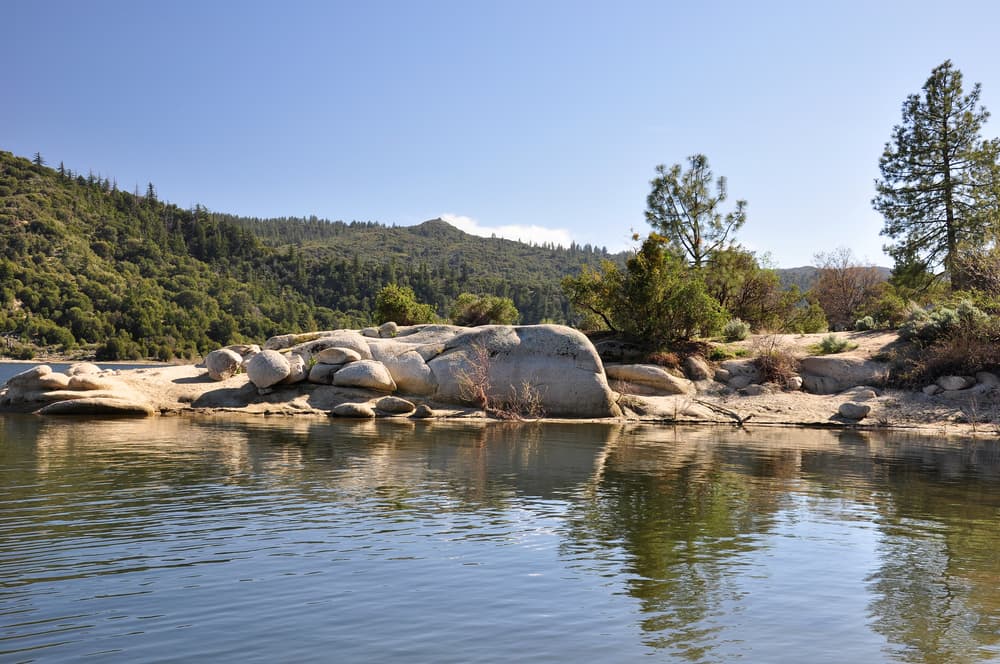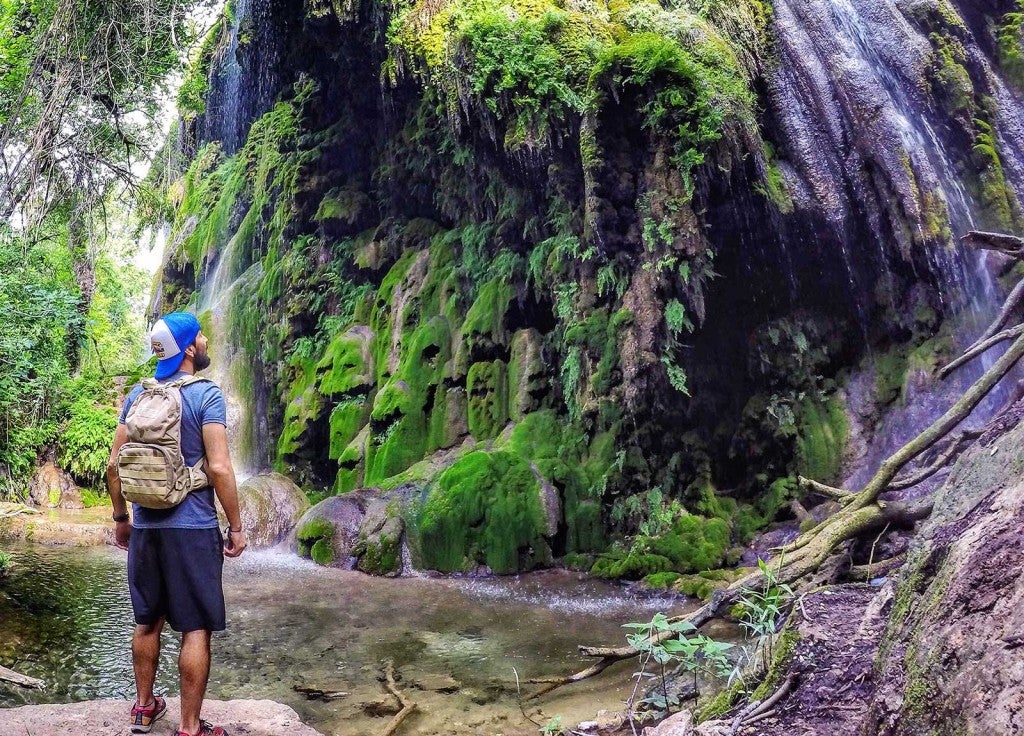On paper, camping in Death Valley National Park doesn’t sound great: it’s the hottest, driest place in all of North America. At 282 feet below sea level, it’s also lower than anywhere else on the continent. Based on these extremes, you’d be forgiven for thinking it sounds a little bit like hell.
It’s not, of course. Death Valley National Park is wild and wooly, but it leaves a lasting impression. It’s surprisingly close to Las Vegas, less than a three-hour drive over the border into California. Campers come each year to admire the park’s towering peaks, salt flats, and plummeting valleys, marveling at the colors that only a desert can create.
Death Valley camping is best planned carefully—weather conditions, especially temperature, can seriously impact your experience. Here are five pieces of advice from The Dyrt campers to help you make the most out of your trip.
1. Prepare for temperature control

Image from The Dyrt Camper Jen G.
The heat in Death Valley is no joke. A visit in the summer can be nearly unbearable, and even in the springtime, visitors should be prepared for potentially dangerous heat. In July of 2017, Death Valley broke a 100-year record for their hottest month ever with an average temperature of 107.4 degrees Fahrenheit.
There is something very cool (wait, no — hot) about visiting a place of such extremes. But it requires extra planning and precaution.
“Personally, I would say that if you plan on camping in Death Valley, you should either plan on visiting in the winter, or bringing an RV. The RV sites at Furnace Creek are excellent, with nice pull-throughs and a good amount of space. That, or bring along a homemade swamp cooler or air conditioner of some type, because otherwise you’re likely to be quite miserable. (Just being honest! And I do recognize we’re pretty crazy for camping there in the first place.)” — The Dyrt camper Jen G.
2. Sleep off the ground

Image from The Dyrt camper Brian K.
Sleeping out in the open might not be a great idea in Death Valley. Zip yourself up in your tent to avoid scorpion encounters. Or sleep in a hammock for some extra ventilation and off-the-ground protection.
“I’ve stayed here every year for the past four years as part of a class studying Mojave Desert Ecology generally the last Friday in May. 3/4 years it’s been very windy though this past year it wasn’t. The temperatures can also be quite hot. Sleeping off the ground or in a tent is a must as we catch lots of sidewinders and scorpions every year in the campsite.” —The Dyrt camper Brian K.
3. Cool off with a day pass

Image from The Dyrt camper Krista R.
There are some great campgrounds in Death Valley that allow you to sleep under an incredible view of the stars. But you might also want to treat yourself to a day pass or a night at The Oasis, where you’ll find green grass, a gorgeous pool, and even a golf course!
“Death Valley is spectacular. This campsite [Furnace Creek] is only a short drive from Badwater Basin (the lowest point in North America!) and Artist’s Drive, where volcanic deposits pain the hills with many colors. The campground itself is nice, and there are even trees for shade at most sites. The facilities are nice and well maintained, however you will need to go elsewhere to shower. The resort nearby offers day passes to their pool, a great place to relax and cool off!!” — The Dyrt camper Krista R.
4. Get a backcountry permit
While there are tons of adventures in Death Valley , we think the best ones reside in the backcountry. Backcountry permits allow Death Valley campers to venture deeper into the desert, or camp just off the road, instead of at crowded campgrounds. Just be sure to park directly adjacent to the road, set up camp at least 100 yards from any water source, and bring plenty of your own water to stay hydrated in the heat. Backcountry permits can be obtained for free at the visitor’s center.
“For two nights, we suffered through Sunset Campground, but for our third and fourth night, we purchased a backcountry permit, which allowed us to park and camp along the park’s dirt roads, at least one mile from any paved roads. These were the nights we’ll remember fondly throughout our time in Death Valley. Take our advice and skip right over Sunset Campground.”
—The Dyrt campers SwitchbackKids
5. Score a free campsite at Wildrose Campground
Much of Death Valley is vast desert floor and rolling sand dunes. But you’ll also find mountains! And on these mountains, you’ll find delightfully cooler temperatures.
Wildrose Peak is the second tallest mountain in the park (Telescope Peak is the tallest), and Wildrose Campground provides easy access to the trail that leads to the peak. The hike to the top of Wildrose Peak is 8.4 miles round-trip, and if you visit in the spring, you might even find snow at the top.
“Nestled in the mountains just west of Death Valley this campground is a cool (both temperature and vibe) place to stay. I camped here in late March just before temperatures got outrageous. It’s about a 45 minute drive from Stovepipe Wells (which has gas, food and other services), but the elevation and thus cooler temperatures are well worth the extra time and gas… The campground has 23 sites pit toilets, potable water, fire rings and picnic tables. It’s first-come first serve but I had no problem getting a spot despite the fact that I arrived after sunset. The best part of this campground is that its FREE!!!” — The Dyrt camper Amanda D
Related Articles:
Related Campgrounds:
- Stovepipe Wells Campground, Death Valley National Park, CA
- Valley of Fire Campground, Overton, NV



